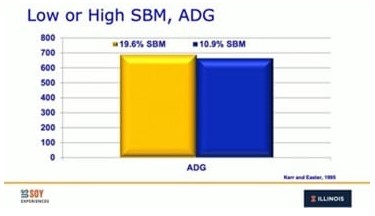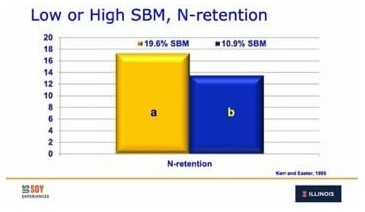U.S. Soy has a large market in animal feed because of its rich nutritional value and its contribution to animal performance. Although alternatives exist, such as corn protein, and a growing supply of synthetic amino acids, research consistently shows that when compared to these alternatives, soy outperforms.
Dr. Hans H. Stein, a professor of Animal Science at the University of Illinois, Urbana-Champaign, conducts research in the area of intestinal physiology and feed ingredient evaluation. In October, he did an in-depth presentation based on relevant studies on the essential amino acids necessary for a healthy pig, and how different protein meals, such as soybean and corn, meet those requirements.
The main conclusion from Stein’s presentation is that soy protein not only provides most of the essential amino acids required to maintain a healthy pig, but it has other notable benefits as well.
In the presentation, Stein outlined four key takeaways:
- Soybean meal is more than amino acids.
- Soy protein may support the immune system.
- Corn protein is high in the branched chained AA leucine.
- Excess leucine results in degradation of valine, isoleucine and tryptophan.
The following chart, provided by Stein, outlines the amino acid levels required for optimal pig health, and how soy protein, corn protein, and combined soy and corn protein meet those requirements.

When soy protein is combined with corn protein, every amino acid level requirement is met. Therefore, combining soy and corn protein for pig meal is a general practice.
Several studies indicate that soy protein is essential to a healthy pig. For starters, soybean meal provides more nutritional benefits than just amino acids, as outlined in Stein’s first takeaway.
“Some studies have focused on other compounds that soybean meal provides, and they have indicated that yes, there are some other compounds in soybean meal that may be important in particular for pigs that are immune challenged,” Stein said.
There is still more research to be done to discover other benefits soy has, Stein said.
He shared research from a study comparing the difference in soy protein and synthetic amino acid levels in pig feed. Although lower amounts of soybean meal can support a similar average daily weight gain in pigs to the same degree as a higher soybean meal diet, the way the pigs synthesize the protein is different.

In the first chart, although containing a higher amount of soybean meal, 19.6%, there is a similar average daily gain (ADG) in pigs as the lower soybean meal, 10.9%.

However, when specifically looking at Nitrogen-retention (N-retention), there is a significant difference between the higher and lower soybean meal. Stein explained this indicates that the pigs didn’t synthesize as much protein and didn’t produce as much muscle protein as the pigs fed the diet with the higher concentration of soybean meal. The average daily gain is similar because in the lower soybean meal, some of the ADG gain went to fat as opposed to protein. As a result, it is not possible to get the same performance of these pigs on a lower soybean meal diet and synthetic amino acids because they did not have the same N-retention.
When it comes to ensuring pigs get the levels of amino acids required, the balance needs to be right. For example, Stein explained that when pigs are given corn protein mixed with synthetic amino acids, there is a risk of pigs having excess amino acid leucine. As noted in Stein’s third takeaway, corn protein has high levels of the branched chained AA leucine. Too much leucine can lead to degradation of isoleucine and valine and reduced utilization of tryptophan, which may result in reduced feed intake.
Through technological advancement, demand for synthetic amino acids — intended to be a less-expensive alternative to soybean meal — has been growing dramatically, according to Stein.
“The only reason why producers would not use soybean meal is if they can use something else that is less expensive,” Stein said. “That is the main reason for using synthetic amino acids instead of soybean meal.”
Click here to see more...